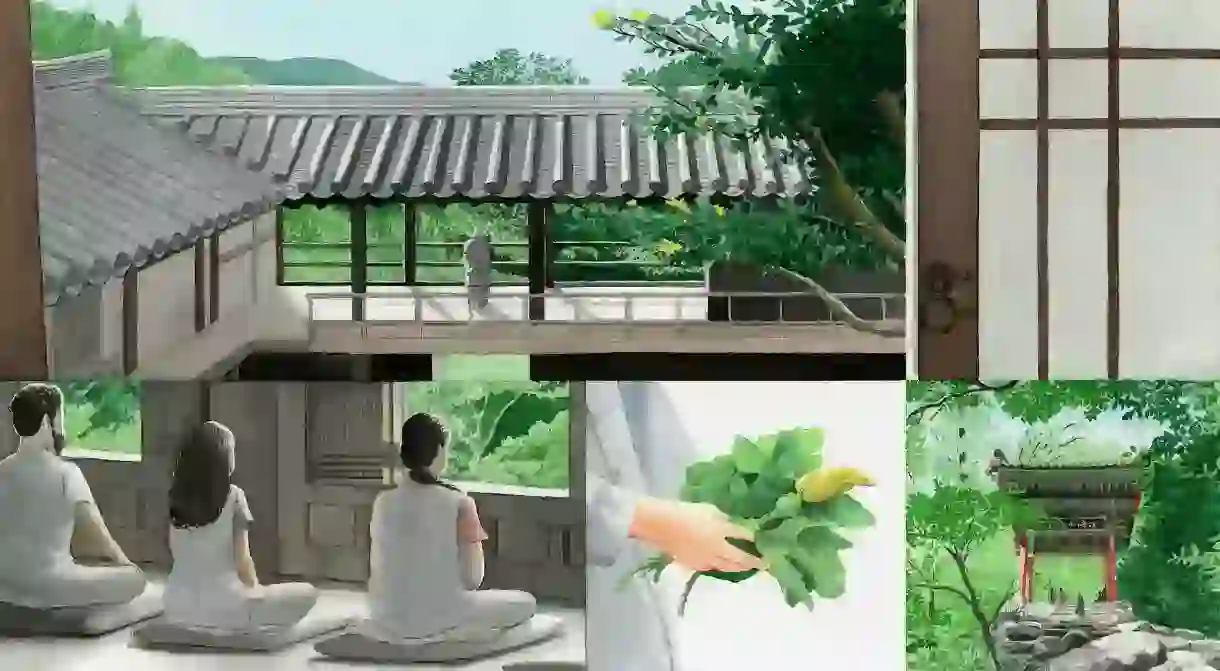How Going on a Korean Templestay Will Help You Find Your True Self

Home to more than 900 Buddhist temples, Korea is teeming with spiritual sites worth exploring. But if you want to truly experience the tranquility of monastic life first-hand, then a templestay is a must. From learning meditation practices to mindfully eating temple cuisine, these experiential programmes offer many activities that allow you to shift your focus inward – away from the chaos of the outside world – in order to find your true self. For a fundamental insight into Buddhism, here’s an outline of what to expect if you embark on a Korean templestay.

Get a crash course in Korean Buddhist culture
Once the official state religion, Buddhism remains deeply rooted in Korean culture; it continues to have a profound influence on the country’s art, literature and architecture, from pagodas and ceramics to developments in printing techniques.
Fortunately, you don’t need to be a Zen master to experience the country’s rich Buddhist heritage. The Templestay program provides an introduction to Buddhist life over the course of a short stay, usually one to two days. And since all participating temples are following Covid-19 precautions, including social distancing, regularly sanitising temple grounds and compulsory face masks, a templestay is a great way to safely enjoy a cultural experience during the pandemic.

Spend a day in the life of a monk
During a templestay, visitors are completely immersed in the monastic lifestyle, from the simple cotton uniform you’re expected to wear, right down to the modest floor mat you sleep on.
Throughout the experience, participants learn Buddhist practices, assist with temple tasks and engage with the resident monks – most speak English beautifully and are eager to chat. Similarly, guests are expected to follow temple etiquette, which includes keeping noise to a minimum, treating all objects with respect and refraining from smoking and drinking alcohol. The distraction-free setting helps to quiet busy thoughts and enhance your meditative journey.

Live in the moment
The ultimate goal of Buddhism is to achieve nirvana – freedom from desire, suffering and a sense of self, allowing you to become fully present in life. Meditation is a tool to reach this spiritual state and a skill you’ll hone during your templestay.
Meditation activities vary by temple, but all include prostrating, or bowing to the Buddha, which is said to humble the mind. Another practice of focus is yeombul – the chanting of Buddha’s name and an act that aims to calm the mind and remove one’s sense of karmic burden. Daily activities such as early morning chores and eating in silence cultivate mindfulness and illustrate how living in the moment can easily become a larger part of your own daily routine.

Wonder at Korea’s spectacular natural landscapes
Most Korean temples are tucked away in the mountains, as they are believed to have optimum pungsu-jiri, or feng shui. Participating in a templestay is a great way to escape the urban buzz and marvel at nature’s wonders in serene surroundings.

Particularly noteworthy is Magoksa, an isolated temple situated on the slopes of Mt. Taehwa in Gongju. Here, the aromas of cherry blossoms and magnolias fill the air in spring and foliage seemingly becomes one with the vibrantly coloured temple buildings in autumn. Guided meditative walks through the forest around the complex awaken the mind and refresh the body.
For something more coastal, Mihwangsa in Haenam County offers vistas of the West Sea and is famous for its sunrises. Watch the first one of the year – a Korean tradition – during the temple’s special New Year program.

Tuck into delicious temple cuisine
Completely vegetarian and lacking many ingredients that traditional Korean fare is associated with – onion, garlic and leeks, to name a few – Korean temple cuisine may sound rather bland. But the dishes – most of which are made from produce and sauces grown or produced in mountains where the temples are located – are pungent, tart and possess dizzying layers of flavour. As well as being vegetarian, many of the dishes are also vegan, healthy, ecofriendly and utterly delicious.
Baekyangsa, home of monk and chef Jeong Kwan Sunim of Chef’s Table fame, offers guests the opportunity to further explore this rich gastronomy through an interactive program with Kwan herself. In addition to savouring the flavours of the food, visitors can learn more about the spiritual side of temple cuisine, including its connection to the body and mind, as well as the key Buddhist practice of only taking what you need.

Get out of your comfort zone
Some templestay programmes feature special activities based on their location and spiritual focus. Golgulsa, for example, invites guests to learn the basics of sunmudo, a Korean martial art that unifies the body and mind through breath control.
Other activities include foraging, coffee roasting classes, tea ceremonies and creating sand mandalas. By getting out of your comfort zone and trying something new, you’ll likely take more away from your templestay than just memories. You’ll learn things you never knew you were capable of and your ‘true self’ might even surprise you.

Where to do a templestay
One of the most popular experiences in South Korea, there are templestay locations all over the country. Whether you want to incorporate one into a stay in Seoul, the lively capital city, or venture into the countryside for an even more authentic experience, you can find a selection of places to book at Templestay.com.

To discover even more about Korea’s compelling culture and to start planning your trip, visit english.visitkorea.or.kr













